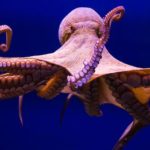Paper, Bioinspired locomotion and grasping in water: the soft eight-arm Octopus robot
The octopus is an interesting model for the development of soft robotics, due to its high deformability, dexterity and rich behavioral repertoire. To investigate the principles of octopus dexterity, we designed an eight-arm soft robot and evaluated its performance with focused experiments. The OCTOPUS robot presented here is a completely soft robot, which integrates eight arms extending in radial direction and a central body which contains the main processing units. The front arms are mainly used for elongation and grasping, while the others are mainly used for locomotion. The robotic octopus works in water and its buoyancy is close to neutral. The experimental results show that the octopus-inspired robot can walk in water using the same strategy as the animal model, with good performance over different surfaces, including walking through physical constraints. It can grasp objects of different sizes and shapes, thanks to its soft arm materials and conical shape.
Learn about our two Decals!
 Click here to find out more about our Fall Bioinspired Design Decal and our Spring Bioinspired Design in Action Decal – ALL MAJORS are welcome.
Click here to find out more about our Fall Bioinspired Design Decal and our Spring Bioinspired Design in Action Decal – ALL MAJORS are welcome.Berkeley BioDesign Community
 Click here to learn about the BioD: Bio-Inspired Design @ Berkeley student organization or here to signup for more info.
Click here to learn about the BioD: Bio-Inspired Design @ Berkeley student organization or here to signup for more info.Search
Student Login




I imagine that the neurological circuits underlying these processes are governed by both 2d spacing maps with their brains as…
to reduce the impact of car accidents, it may be possible to study the force diverting physics of cockroaches to…
you see this type of head-bobbing stability in many avian creatures related to pigeons like chickens. the head ability to…
not like they taught horses how to run! this is an example of convergent evolution where both sea creatures and…
The brain functions in a similar way with neuronal connections. our brains are able to utilize the multiplicity of connections…